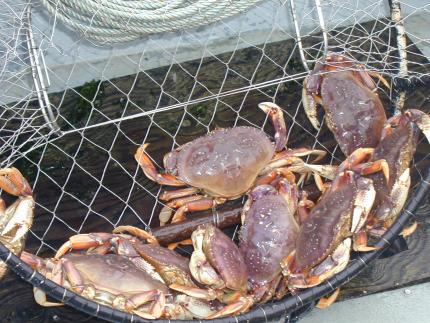ARCHIVED NEWS RELEASE
This document is provided for archival purposes only. Archived documents
do not reflect current WDFW regulations or policy and may contain factual
inaccuracies.
News release Dec. 22, 2020
Dan Ayres, 360-470-3557; Jason Wettstein 360-704-0258
OLYMPIA – Recreational Dungeness crab fishing will close in Willapa Bay and remain closed in Grays Harbor, while crab fisheries on the Washington coast north of Point Chehalis will reopen, Washington Department of Fish and Wildlife (WDFW) shellfish managers announced today.
Shellfish managers closed crab fishing today (Dec. 22) in Willapa Bay and the popular Tokeland Marina after testing showed domoic acid levels in crab for these waters exceeded standards for safe consumption established by the Washington State Department of Health (DOH). Previous closures on Grays Harbor and the Westport Boat Basin also remain in effect due to elevated marine toxin levels.

“While we are seeing better news in some coastal areas, unfortunately toxin levels have now risen in Willapa Bay and are still high in Grays Harbor and in ocean areas on the southern half of our coast,” said Dan Ayres, WDFW coastal shellfish manager.
Re-opening for crab fishing north of Point Chehalis was approved by fishery managers after testing showed domoic acid levels in crab met standards for safe consumption in these coastal areas. Inside the Columbia River (from the outer jetty tips upriver) will also remain open given acceptable test results from DOH.
“Marine toxin sampling will continue in all marine areas as weather and ocean conditions allow,” said Ayres. “We continue to hope more areas can open and make these decisions based on test results from the Department of Health.”
Domoic acid, a natural toxin produced by certain types of marine algae, can be harmful and even fatal if consumed in sufficient quantities. Cooking or freezing does not destroy domoic acid in shellfish.
The commercial Dungeness crab fishery is also closed and will be delayed until at least Jan. 14 in Washington coastal waters south of Point Chehalis, Grays Harbor, Willapa Bay, and the Columbia River.
Harvesters can find up-to-date information on seasons and shellfish safety information on the Washington Shellfish Safety Map webpage.
Levels of domoic acid have increased in coastal waters over recent months. Earlier this season, the department closed all Washington coastal beaches to razor clam digging due to high levels of the toxin.
DOH recommends that crabbers who are fishing outside of the current closure area remove the crab viscera from their catch - to avoid any exposure to possible toxins.
All sport crab gear in the new closure areas must be removed immediately or it will be subject to confiscation by Fish and Wildlife enforcement officers.
November and December closures represent the first time since 2015 that crab fisheries have been closed in Washington due to domoic acid. The toxin was first detected on the Washington coast in 1991.
Regular testing of shellfish species found in the area - including oysters, hard-shell clams and mussels - shows those shellfish remain safe to eat. The exceptions are razor clams and Dungeness crabs.
Harvesters are advised to check the WDFW web page for any updates.
More information about domoic acid can be found on WDFW's domoic acid webpage.
The Washington Department of Fish and Wildlife is the primary state agency tasked with preserving, protecting and perpetuating fish and wildlife and ecosystems, while providing sustainable fishing and hunting opportunities.